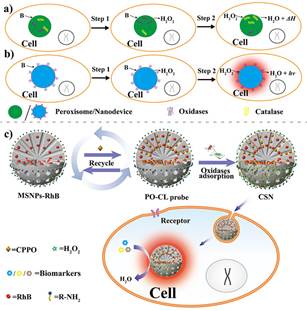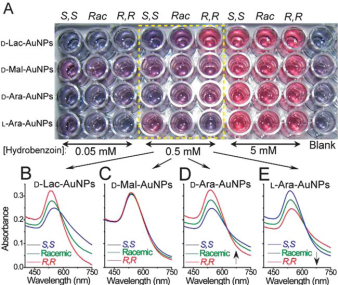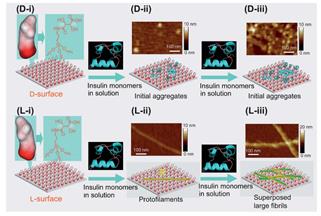1. Biological and pharmaceutical analysis, and optical diagnosis
Functional probes based on organic molecules, nanomaterials, and their hybrids are designed for functional detection (i.e. spatiotemporal, organelle targeted, in vivo imaging) of various molecules. We mainly focus in development visual sensors based on adsorption and luminescent signal for the purpose of rapid, in situ, and in vivo analysis. Especially, sensors based on chemi- and bioluminescent signal are our most interest ones due to high sensitivity and ready miniaturization. Representative work is as following.

Peroxisome-Inspired Chemiluminescent Silica Nanodevice for Intracellular Detection of Oxidase-Catalyzed Biomarkers and Its Application for Insulin Sensitizer Screening.
2. Visual chiral analysis
Generally, enantiomers of chiral molecules show the same physiochemical properties under achiral environments. Thus, discrimination of enantiomers is a difficult task, and especially for visual chiral differentiation. Our work is for the purpose of simplify the difficulty of chiral analysis.

A general approach using spiroborate reversible cross-linked Au nanoparticles for visual high-throughput screening of chiral vicinal diols.
3. Preferential interaction between chiral organic or inorganic environment and biomolecules
Chirality is integral to biological complexity. One of life’s distinctive biochemical signatures is the high selectivity of chiral molecular species. As a result, many biological events are greatly influenced by the chirality of molecules. For example, we found that materials with different surface chirality have different regulatory effects on the conformational changes of proteins, and the conformation of proteins is closely related to their biological functions. Although chirality is of great significance in biomaterials related biological studies, this field is only at a starting point and a lot of questions still remain to be answered. New investigations of chiral biomaterials may provide insight into the understanding of the origin of the high chiral preference in nature and lead to new strategies for cell manipulation and tissue engineering.

Using the classical biogenic chiral molecules, D- and L-tartaric acid, assembled into monolayers as a model chiral surface, we reported for the first time that surface chirality modulated insulin assembly, including the dynamics of adsorption, kinetics of the conformational transition and fibril formation, on D- and L-surfaces and determined the cellular effect of insulin on neuronal PC12 cells.



